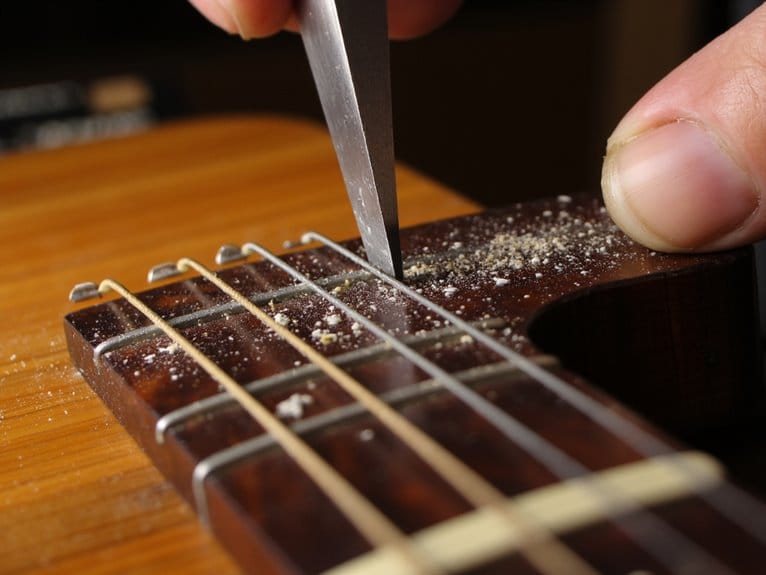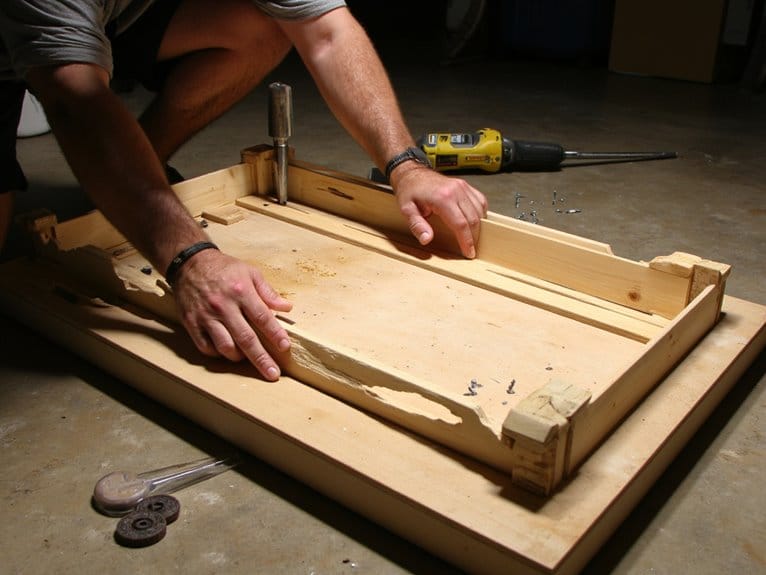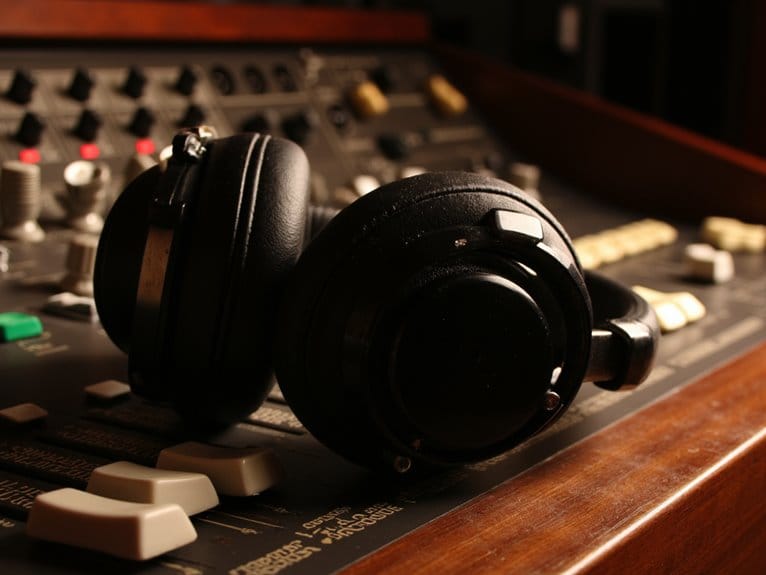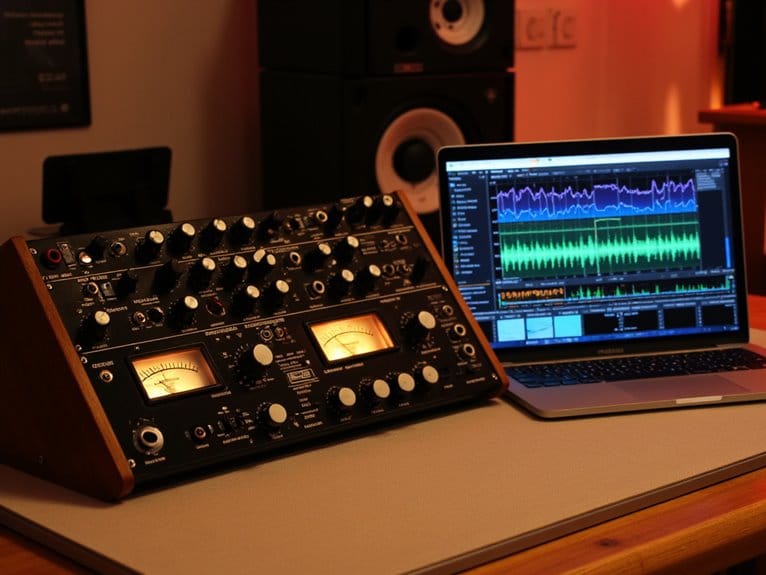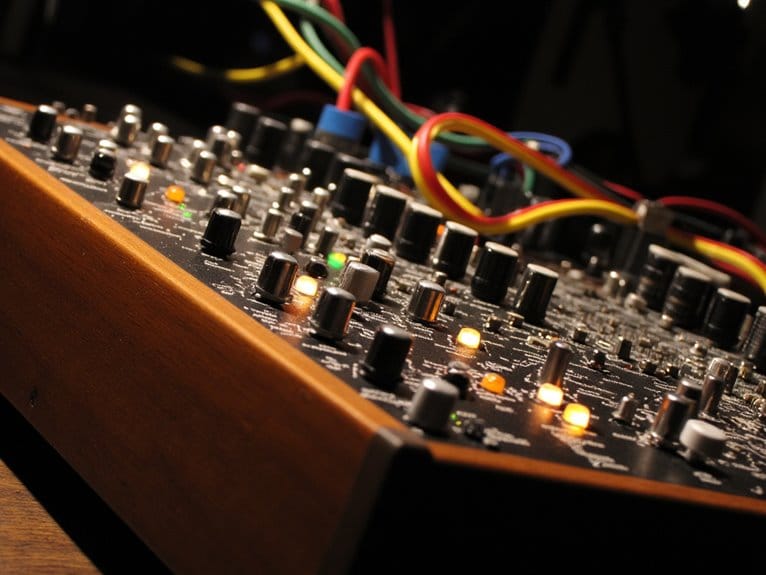Understanding Guitar Effect Types and Their Uses
You’ll encounter five main guitar effect categories that transform your sound: gain-based effects like overdrive and distortion boost signal while adding harmonic saturation, dynamic effects such as compressors control volume and sustain, modulation effects including chorus and flanger manipulate timing and pitch relationships, time-based effects create delays and reverb for spatial depth, and filter effects like wah pedals shape frequency response through strategic signal processing that reveals professional-grade tones.
We are supported by our audience. When you purchase through links on our site, we may earn an affiliate commission, at no extra cost for you. Learn more.
Notable Insights
- Gain-based effects like overdrive and distortion shape core guitar tone through harmonic saturation and signal boosting.
- Modulation effects including chorus, flanger, and phaser manipulate timing and pitch relationships to create movement and texture.
- Time-based effects use delay for distinct echoes and reverb for spatial depth, enhancing ambient qualities.
- Filter and wah effects sweep frequency ranges to emphasize brightness or warmth through pedal motion control.
- Proper effects chain ordering maintains signal clarity: foundation effects first, distortion middle, ambient effects last.
Gain-Based Effects: Boosting Signal and Adding Distortion
While many guitarists focus on expensive amplifiers and pristine pickups, I’ve found that gain-based effects often provide the most dramatic transformation to your sound, serving dual purposes as signal boosters and tone-shaping devices that can make even a modest setup sound professional.
These pedals excel at tone shaping through multiple gain stages that add harmonic saturation, affecting signal dynamics and sound compression in distinct ways. You’ll discover that clean boost functionality preserves your guitar’s natural character while increasing volume, whereas distortion circuits emphasize specific frequency ranges for amplifier interaction.
I particularly appreciate how pedal stacking creates layered saturation levels, and honestly, the expressive playability you gain from understanding these circuits makes the learning curve worthwhile for achieving professional-quality sounds. Many guitarists find that true bypass circuitry maintains signal integrity when pedals are disengaged, preventing tonal loss in complex pedal chain setups. The fundamental operation involves clipping the guitar’s signal, which alters the waveform shape and creates the characteristic harmonics that define each pedal’s tonal signature. Each gain type offers distinct sonic characteristics, with overdrive providing subtle grit, distortion delivering heavier tones for classic rock, compression balancing dynamics, and fuzz creating thick, aggressive sounds for heavier musical genres. Compression pedals specifically enhance guitar tone by smoothing dynamics while providing additional sustain and definition without sacrificing the instrument’s natural character. Understanding essential controls like Gain, Tone, and Volume is critical for effective tone shaping across all gain-based effect types.
Dynamic Effects: Controlling Volume and Attack Characteristics
Dynamic effects represent the unsung heroes of guitar tone shaping, and I’ve learned that mastering these volume and attack controllers can transform your playing from amateur-sounding to professionally polished in ways that many guitarists overlook.
Compression techniques form the foundation, reducing dynamic range while adding sustain enhancement that makes your notes sing longer. I’ve found that proper attack shaping through transient response control can dramatically improve your articulation, whether you’re playing delicate fingerpicking or aggressive power chords.
Volume control pedals offer real-time expression, while noise reduction gates eliminate unwanted hum during silence. These effects guarantee signal consistency across your performance, creating the professional polish that separates bedroom players from stage-ready musicians. Many guitarists don’t realize that volume pedals can affect the overall loudness characteristics of their sound in subtle but important ways.
When recording, these dynamic effects work seamlessly with modern audio interfaces that provide the clean signal path necessary to capture the subtle nuances of your processed guitar tone. Multi-effects processors like those with built-in expression pedals allow guitarists to control these dynamic parameters in real-time during performance.
Modulation Effects: Altering Tone Character Through Pitch and Timing
When you’re ready to add movement and dimension to your guitar tone, modulation effects become your primary tools for creating everything from subtle textural enhancement to dramatic sonic transformation.
These effects work by manipulating timing, pitch, or phase relationships within your signal path, and I’ve found that understanding the fundamental differences between chorus, flanger, phaser, and rotary effects will greatly expand your tonal palette.
You’ll discover that each modulation type offers distinct characteristics, from the lush doubling effect of chorus pedals to the jet-engine sweep of flangers, making them essential components for genres ranging from classic rock to modern indie music. Chorus effects in particular create depth and richness that works effectively across various musical genres including jazz, rock, and pop, with analog circuitry providing the vintage warmth that many musicians prize for authentic tones. Flanger pedals are particularly effective at creating rich dynamic textures that range from subtle enhancement to the classic jet-plane and space sound effects that have defined countless recordings.
Many modern pedals combine modulation with reverb effects to create ambient textures that provide both spatial depth and dynamic movement in your signal chain.
Chorus and Flanger Basics
The shimmering beauty of modulation effects lies in their ability to transform a simple guitar signal into something that sounds like multiple instruments playing in perfect harmony, and nowhere is this more apparent than with chorus and flanger effects.
Understanding these modulation effects requires recognizing their fundamental tonal differences, since each creates distinct sound layering through different approaches.
Chorus characteristics include longer delay times of 15-40 milliseconds with pitch-shifting that produces warm, lush textures perfect for clean rhythm parts.
Flanger techniques utilize shorter 1-10 millisecond delays with pronounced comb filtering, creating metallic sweeping sounds ideal for psychedelic passages.
While chorus smoothly thickens your tone through multiple delayed copies, flangers emphasize dramatic movement through single-delayed signals with feedback loops, making their effect applications distinctly different despite sharing modulation-based foundations.
For guitarists seeking more complex modulation textures, rotary effect pedals offer an alternative approach by combining phaser, vibrato, and chorus elements to recreate the distinctive spinning speaker cabinet sound.
Modern delay pedals feature true bypass functionality to maintain signal integrity when the effect is disengaged, ensuring your core guitar tone remains unaltered during performance.
Many players prefer modulation effects over high-gain distortion when crafting clean tones that need dimensional depth without sacrificing signal clarity.
Phaser and Rotary Applications
Movement defines the essence of phaser and rotary effects, two modulation approaches that reshape your guitar’s tonal character through distinctly different methods of pitch and timing manipulation.
Phaser applications utilize all-pass filters to create sweeping, whooshing textures that enhance your signal without compromising note clarity, making them perfect for funk rhythms, psychedelic rock, and vintage ’70s warmth. You’ll find phasers add subtle shimmer or dramatic sweeping depending on your depth and rate settings. These modulation effects create rich, dynamic textures that expand your sonic palette beyond basic overdrive and distortion.
Rotary speaker effects emulate Leslie cabinet characteristics, producing rich swirling modulation through simulated Doppler shifts that combine vibrato and tremolo components. For comprehensive modulation control, the SONICAKE pedal provides four modulation effects including chorus, flanger, phaser, and tremolo with real-time rate adjustment capabilities.
While phasers rely on phase-shifting filters, rotary effects recreate physical speaker rotation, delivering spatial movement and vintage organ-style character that’s particularly effective for blues, jazz, and psychedelic applications. Among commonly confused effects, pedals like the MXR M-101 Phase 90 offer wah-like tonal variety despite being primarily a phaser, demonstrating how modulation effects can blur traditional categorical boundaries.
Time-Based Effects: Creating Echo and Reverberation
When you’re ready to add spatial depth and atmospheric texture to your guitar sound, time-based effects become your most powerful tools for creating everything from subtle ambient enhancement to dramatic sonic landscapes.
You’ll find that delay pedals serve as your foundation for rhythmic echoes and textural layering, while reverb effects handle the vital task of simulating natural acoustic environments that make your guitar feel like it’s playing in actual physical spaces.
Understanding these fundamental effect types, along with their various implementations and tonal characteristics, will transform how you approach both rhythm and lead guitar contexts across virtually every musical genre. Modern budget reverb pedals now offer professional-quality spatial effects with features like multiple reverb modes and true bypass circuitry at accessible price points under $70.
For musicians seeking to push their signal beyond time-based processing, boost pedals offer an essential tool for driving your amp into natural saturation or adding the extra volume needed to cut through dense musical arrangements. High-gain guitar setups often benefit from noise gate pedals that effectively eliminate unwanted hiss, hum, and feedback while preserving your natural instrument character.
Delay Pedal Fundamentals
Among all guitar effects, delay pedals might be the most deceptively simple yet profoundly transformative tools in your signal chain, taking your original guitar signal and creating echoes that can range from subtle doubling to cascading walls of sound.
Understanding delay pedal mechanics starts with recognizing how they record your incoming signal and play it back after predetermined millisecond intervals, while echo layering occurs when you play additional notes between repeats, creating overlapping atmospheric textures.
Your delay pedal’s core controls shape these repeats through three essential parameters:
- Effect Level – balances wet processed signal against your dry original tone
- Feedback – determines repeat quantity from single echoes to infinite cascades
- Delay Time – sets millisecond intervals creating everything from slapback bounce to expansive ambient washes
Reverb Types Explained
While delay creates distinct echoes you can count and identify, reverb works differently by generating dense clouds of reflections that blend together into ambient washes, transforming your guitar’s natural sustain into spatial atmospheres that can transport listeners from intimate coffee shops to cavernous concert halls.
Spring reverb benefits include that distinctive “drippy” character perfect for vintage surf tones, while plate reverb applications shine on vocals with their smooth, warm density.
Room reverb characteristics offer subtle spatial enhancement without overwhelming your signal, and chamber reverb sounds provide lush vintage warmth heard on classic recordings.
Modern reverb innovations now include special effects reverbs with swell functions and pitch manipulation, letting you craft ethereal soundscapes beyond traditional acoustic spaces.
Filter and Wah Effects: Shaping Frequency Response
As someone who’s spent countless hours tweaking guitar tones, I can tell you that filter and wah effects represent some of the most powerful tools for shaping your instrument’s frequency response.
These effects allow you to sculpt everything from subtle tonal adjustments to dramatic sonic sweeps that’ll make your guitar sing, growl, or cry on command.
These filter applications work by emphasizing or attenuating specific frequency ranges, creating vocal-like effects through strategic tone shaping. Wah techniques involve rocking the pedal to sweep bandpass filters across your signal, while dynamic response settings let your picking intensity control the cutoff automatically.
Three essential filter sweeps for expressive playing:
- Toe-down brightness for cutting solos
- Heel-down warmth for rhythm emphasis
- Auto-modulation for hands-free frequency modulation
Proper pedal settings guarantee signal clarity while maximizing your instrument’s emotional range. Modern multi-effects pedals often include various filter and wah simulations alongside amp modeling and other processing options. While these frequency shaping techniques apply to all stringed instruments, bass players particularly benefit from understanding pickup configuration to achieve optimal tonal versatility.
For players seeking automatic filter effects without manual pedal control, phaser pedals provide similar frequency modulation through their signature swooshing sounds that sweep through your signal path continuously.
Specialized and Synth Effects: Advanced Sound Manipulation
When you’re ready to push your guitar into uncharted sonic territory, specialized and synth effects open up a universe of advanced sound manipulation that’ll transform your six-string into everything from a vintage analog synthesizer to a futuristic sound design machine.
Vocoder effects impose vocal formants onto your guitar signal, creating that distinctive “talking” character through harmonic manipulation. Modern pitch tracking systems enable accurate conversion to MIDI or synthesizer waveforms, while sample synthesis replaces basic oscillators with recorded samples for realistic instrument emulation.
Advanced modulation through phasers and complex chorus circuits generates synth layering effects, producing rich, organic textures that rival dedicated synthesizers. These tone sculpting tools excel at creating complex textures for ambient soundscapes, electronic music, and experimental compositions where traditional guitar tones simply won’t suffice.
Building Your Effects Chain: Practical Applications and Setup Tips
Once you’ve explored the vast landscape of guitar effects from basic overdrives to complex synth manipulations, the real magic happens when you learn to chain them together strategically, creating a cohesive signal path that transforms your individual pedals into a powerful, interconnected sound-shaping system.
Getting your effects order right dramatically impacts signal clarity, and I’ve learned through countless hours of experimentation that proper sequencing prevents the sonic mud that plagues many beginners. Here’s my proven three-step approach:
- Clean foundation first – tuner, compressor, and wah before any saturation hits your signal
- Distortion in the middle – letting overdrive and fuzz shape your core tone before modulation
- Ambience last – delay and reverb preserving their clarity at the chain’s end
Your amp’s effects loop becomes invaluable for maintaining pristine modulation and time-based effects.
Frequently Asked Questions
What’s the Difference Between Analog and Digital Delay Pedals?
Analog delays use bucket brigade circuits creating warm, degraded repeats with natural decay, while digital delays offer pristine sound quality with exact duplicates. Your choice depends on preferred delay characteristics and tonal goals.
Should I Put My Tuner Pedal Before or After My Effects?
Most guitarists prefer tuner pedal placement at the beginning of their signal chain for cleanest tuning accuracy. However, pedal order effects depend on your needs—placing it last creates a master mute switch for silent tuning.
How Do I Prevent Feedback When Using High-Gain Effects at Volume?
You’ll prevent feedback loops by lowering gain levels, positioning yourself away from your amp, using noise suppression pedals like gates, reducing treble frequencies, and keeping your guitar’s volume down while maintaining distance from speakers.
On a final note
Now you’ve got the roadmap to building your effects arsenal, though I’ll admit the sheer number of options can feel overwhelming at first. Start with one effect from each category—maybe a distortion pedal, compressor, chorus, delay, and wah—then expand based on your musical style. Remember, you don’t need every effect immediately; your ears and playing style will guide you toward the sounds that truly enhance your musical expression.


